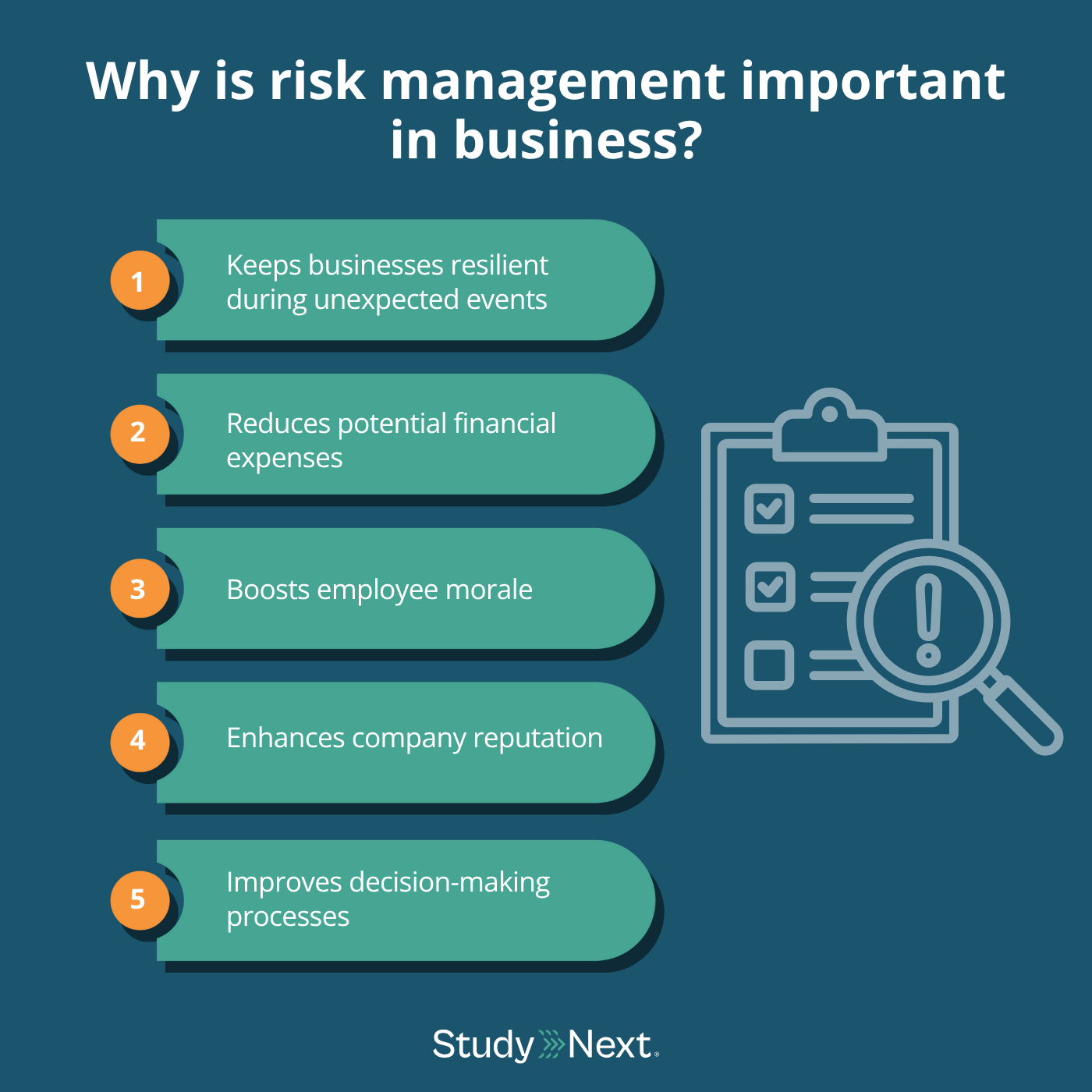In This Article
- What is risk management?
- Common types of business risks
- Common risks faced by Australian businesses
- When do you implement risk management strategies?
- 4 practical steps to manage business risks
- Why is risk management important in business?
- What skills are important in risk management?
- The role of leadership in risk management
- How postgraduate study can enhance risk management skills
- Translate risks into opportunities with postgraduate study

In a fast-evolving business landscape, companies are often exposed to various types of risks, including financial instability, cybersecurity threats and reputational harm, that may cause disruptions to their daily activities. It’s important to know how to anticipate and navigate these potential threats effectively to ensure long-term organisational growth and success.
This article explores some of the most common types of risks businesses encounter and provides a step-by-step guide on how to manage business risks. You’ll learn why risk management is vital in business, which skills are valuable in this field and how leadership plays a crucial role in fostering a risk-aware workplace culture. We’ll also delve into how postgraduate study can strengthen your ability to manage complex risks in today’s business world.
What is risk management?
Risk management involves identifying possible risks across diverse business areas, understanding their potential impact and preparing strategies to mitigate or respond to them. Risks can take many forms, such as technical issues, natural disasters, negative online feedback, staffing challenges or any potential threats that can disrupt an organisation’s operations and performance. Businesses need to manage these risks in advance to prevent their occurrence or reduce their impact.
Common types of business risks
Businesses typically face a wide range of risks, including financial, operational, legal, security, reputation, work health and safety and opportunity risks. These risks may significantly affect business operations if not managed properly. Here’s what they entail:
Financial: These risks involve potential losses due to factors like poor cash flow, debt or economic fluctuations. They can greatly affect business performance and its ability to remain profitable.
Operational: Internal challenges, such as staff shortages and poor project management, and external issues, including fraud and natural disasters, can cause disruptions to an organisation’s daily activities, which can lead to delays and reduced productivity.
Legal: Legal risks can happen when businesses fail to comply with relevant state and federal laws or contractual obligations. They can lead to costly lawsuits and reputational damage.
Security: This risk often involves unauthorised access to corporate data and assets. These breaches can expose and compromise sensitive data like customers’ personal details.
Reputation: An organisation may encounter reputation risks if it displays unethical behaviour or delivers poor-quality products or services. This can result in reduced revenues and diminished trust among customers and shareholders.
Work health and safety: This type of risk involves hazards that may harm employees, such as faulty equipment and unsafe workplace layouts. It also covers psychological hazards like harassment, discrimination and misalignment between employee skills and job responsibilities.
Opportunity: When an organisation allocates its resources to one opportunity over others, it risks missing out on potentially more beneficial outcomes, as the selected opportunity may not end up being the most advantageous for the business.
Common risks faced by Australian businesses
In recent years, Australian businesses have faced growing challenges related to cybersecurity, rising cost of living and talent shortages. These issues can pose significant threats to their operations, financial stability and long-term vitality. Find out more below:
Cybersecurity threats
The Allianz Risk Barometer report in 2024 found that cyber incidents emerged as the top business concern in Australia. As more businesses across sectors undergo digital transformation, they may also become more vulnerable to cyber threats. This trend is further supported by Vanta’s State of Trust Report 2024, where 52 per cent of Australian businesses are most concerned about cybersecurity risks, while 50 per cent are worried about data breaches and the loss of sensitive information. These concerns extend beyond internal operations, as 45 per cent reported that a vendor experienced a data breach during their partnership. While the issue originates externally, 60 per cent believe that these third-party breaches negatively affect their reputation, with two in five businesses ending vendor relationships due to security issues.
Third-party risks don't just involve data breaches. According to PwC’s Global Economic Crime Survey 2024, 47 per cent of Australian companies experienced fraud in the past two years. Fraud involving third parties, such as vendors and contractors, can lead to major financial and operational consequences for businesses of all sizes, regardless of their sector or geographic location. These findings demonstrate a rising need for Australian businesses to boost their cybersecurity efforts and third-party risk management strategies to protect themselves in today’s business landscape.
The rising cost of living
The rising cost of living is significantly impacting businesses, especially small businesses. The 2024 Small Businesses Perspective Report by the Council of Small Business Organisations Australia and Commonwealth Bank found that the cost of doing business, including rent, utilities and interest rates, has become a major concern. 46 per cent of small businesses reported increased operating expenses, while one in four business owners had to resort to using their personal savings to keep their business afloat.
Besides affecting internal business operations, the increasing living costs also pose external risks. Inflation can influence consumer purchasing behaviour, as customers become more cost-conscious about how they spend their money. They may cut back on non-essential purchases and prioritise affordability over brand loyalty. For businesses, this shift can lead to reduced revenue and greater competition for customers. Small businesses are especially vulnerable, as they often lack the flexibility to adjust their pricing to stay competitive. If organisations fail to adapt to these shifting consumer patterns and rising living costs, they risk facing significant financial and operational challenges that could impact their long-term sustainability.
Talent shortages
The 2024 Allianz Risk Barometer report identified the shortage of skilled workers as one of the top three business concerns in Australia. This has been a persistent challenge, with Jobs and Skills Australia reporting that nearly 30 per cent of occupations are facing a national shortage in 2025. A lack of skilled talent can pose serious risks for businesses, as it may force existing employees to take on more tasks than they can manage. This strain can potentially lead to reduced productivity and compromise the quality of products or services, which can put an organisation’s reputation at risk.
If staffing issues persist, the ongoing strain on employees can increase the chances of burnout and turnover, further contributing to workforce gaps. In Australia’s current business landscape, strategic workforce planning is critical to maintain business resilience and operational stability.
When do you implement risk management strategies?
Applying risk management strategies is often an ongoing process across various business situations. It’s important to analyse the potential risks an organisation may face in situations such as:
- Launching or expanding a business
- Entering new markets Investing in new workplace equipment
- Implementing new technologies
- Developing products and services
- Designing workplace environments and practices
- Working with suppliers and vendors
- Developing growth and cost reduction strategies
- Addressing physical and psychological workplace concerns
- Responding to industry trends and economic shifts
4 practical steps to manage business risks
Risk management typically begins with identifying potential risks, analysing their possible impacts and developing strategies to manage them. Once these strategies are implemented, they should be monitored regularly as risks can change over time. By taking these steps, businesses can better position themselves to expect and handle potential disruptions. Find out more in this step-by-step guide below:
1. Identify potential risks
The first step in risk management is identifying the types of risks your company may encounter. You can start this process by conducting an internal review to pinpoint areas that are most vulnerable to threats. This may involve analysing historical data like financial statements and workplace safety reports, or conducting a strengths, weaknesses, opportunities and threats (SWOT) analysis to examine your organisation.
It’s also crucial to look beyond internal operations and consider external factors that have the potential to negatively impact your organisation. Keeping up with the latest industry developments, economic trends and regulatory changes can help you anticipate and mitigate emerging threats.
When identifying risks, it’s important to engage with key stakeholders, such as staff, vendors, customers and investors, to gather their insights that can enhance your risk management strategies. For example, a technology company preparing to launch a cloud-based product may consult developers to highlight data security concerns. Similarly, examining negative customer feedback on product or service quality can reveal reputational risks a business may face. Consulting stakeholders helps you gain a clearer understanding of which risks are considered high or low priority and how to address them accordingly. Having regular dialogue with them can also keep your company’s risk framework up to date and responsive to any unexpected challenges.
2. Examine the impact of risks
Once risks are identified, it’s important to measure their potential impact on your company. It may be overwhelming to address every threat of varying sizes, so it’s usually more practical to quantify each risk and prioritise your resources to address threats that may cause major disruptions to the business. To determine the risk level of each threat, you can refer to this simple formula from the Australian Government’s official business portal:
Likelihood x Impact = Risk level
Likelihood refers to the possibility of a risk happening, while impact measures the severity of the damage that the risk can cause if it happens. You can establish a rating system to determine the risk score by assigning numerical values, such as the following example:
| Likelihood | 1 (highly unlikely) to 5 (highly likely) |
| Impact | 1 (minimal damage) to 5 (severe damage) |
Multiplying these values gives you a risk score ranging from one to 25. The higher the score, the more urgent the need to mitigate the risk. Using the same example, you can create a scoring system to help rank risks by urgency, such as:
| Low risk (1–5) | Does not require preventive action |
| Moderate risk (6–15) | Should be addressed within a reasonable timeframe |
| High risk (16–25) | Requires immediate preventive action |
You can use this scale to rank your risks from least urgent to most urgent to determine how they should be handled. Keep in mind that this scale can be customised to suit your organisation’s needs and risk tolerance.
3. Develop and implement strategies to manage risks
The next step is to design and execute an appropriate risk management plan. Depending on the risk level, your plan may involve avoiding, removing or reducing the impact of each risk. You may even accept a low-level risk, especially if the cost of mitigating it outweighs the potential outcomes, or if the benefits of taking the risk are much higher than the possible damage it may cause.
When determining the most suitable strategy, you need to consider various ways to treat the risk, the resources required and the timeline for implementation. You can prepare contingency plans for risks that may still happen despite preventive measures, ensuring your business can respond quickly and minimise disruption. It can also be helpful for risk management plans to have responsibilities assigned clearly so team members know what to do in the event of a crisis. Having this clarity can help organisations recover fast.
Once these strategies are finalised, they should be communicated across the organisation and to relevant stakeholders like clients and suppliers. Not only can this help everyone involved to be better prepared to respond if risks arise, but it also fosters transparency, which can build confidence in your company’s ability to anticipate and manage potential threats.
4. Monitor and commit to risk strategies
Risk management doesn’t just end after creating and implementing risk strategies. It’s an ongoing process that requires continuous refinement and attention. It’s important for businesses to check the effectiveness of their risk management plans over time. They need to be adaptable as risks can evolve due to changes in various environments, such as internal operations, regulations, market conditions and technological advancements. By regularly examining and updating your risk management framework, you can check for emerging risks and reanalyse the severity of threats that have been mitigated to give focus on other risks that require more attention.
Establishing systems to measure the success of your risk management plans can help you commit to these risk strategies. You can also gather feedback from stakeholders within and beyond your organisation, such as employees, customers and vendors, and use their insights to improve your strategies. Another way to commit to risk management is to integrate risk awareness into workplace culture by educating new hires and existing employees through training programs. These efforts can ultimately help contribute to an enhanced operational performance, driving long-term growth for your organisation.
Why is risk management important in business?
Risk management is essential in business for several reasons, including helping companies stay resilient during unexpected challenges, reducing potential financial costs, enhancing employee morale, strengthening company reputation and improving decision-making processes. These benefits can contribute to a stronger overall company performance and profitability. Learn more below:

Keeps businesses resilient during unexpected events
Effective risk management can help businesses navigate unforeseen challenges like equipment failure, natural disasters or economic downturns. By developing tailored response protocols for various unexpected scenarios, they may reduce business downtime by minimising operational disruptions. This can help keep businesses afloat during times of uncertainty or even maintain profitability despite challenging circumstances.
Reduces potential financial expenses
When organisations take proactive measures to identify risks early, they can spot and prevent financial threats, including fraud, theft and operational inefficiencies, before they escalate into costly problems. Companies with strong risk management practices in safeguarding their assets may be more likely to qualify for lower insurance premiums. Ensuring that business activities comply with relevant regulations can also help minimise the chances of facing expensive legal penalties and lawsuits. These measures can ultimately help protect an organisation’s financial health.
Boosts employee morale
Risk management plays an important role in creating a safe and supportive environment for employees to work in. When they’re given the necessary physical and psychological resources to perform their tasks well, they’re more likely to feel motivated to work towards organisational goals, which can boost productivity. Having strong risk management measures can also give employees peace of mind, especially during emergencies, knowing that their work is less likely to be disrupted by unexpected situations.
Enhances company reputation
Businesses that execute effective risk management strategies can build confidence and trust among customers, suppliers, employees and shareholders. By demonstrating their ability to anticipate and navigate a wide range of challenges, these organisations can display their resilience in a rapidly evolving business environment. This can ultimately help strengthen their reputation and maintain positive relationships with key stakeholders.
Improves decision-making processes
When organisations consistently incorporate risk management into their operations and strategic planning, they’re better equipped to make more informed decisions. This usually involves finding early warning signs of potential challenges, reflecting on past successes and mistakes as well as determining whether past decisions remain effective or require adjustment. By taking these measures, they can improve their chances of achieving better business outcomes.
What skills are important in risk management?
Important risk management skills can cover a combination of hard and soft competencies. Hard skills, including business acumen, legal knowledge and data literacy, offer a technical foundation to identify and examine risks. Soft skills like problem-solving, communication and adaptability help you respond to these risks and implement practical strategies to manage them. Find out what they entail below:
Business acumen: Understanding organisational goals and the best practices in business operations can provide you with valuable insight when identifying risks that can impact performance. This knowledge helps you examine the potential outcomes of business decisions and make more informed choices.
Legal knowledge: Businesses function within complex regulatory environments, making legal compliance a vital aspect of risk management. Having legal expertise can help you pinpoint possible legal risks and liabilities in contracts, policies and operational procedures. This can help prevent regulatory breaches and ensure a company’s products and services comply with relevant industry standards.
Data literacy: Developing risk management strategies often requires the ability to analyse and interpret risk-related data. This skill is also essential for you to leverage risk assessment tools effectively in identifying potential risks, evaluating their impacts and determining how they should be prioritised and managed.
Problem-solving: The purpose of finding risks in various business scenarios is to address potential issues before they can actually happen or minimise their impact if they do. Strong problem-solving skills can help you understand the root causes of different types of risks, develop effective strategies to manage them and translate them into action.
Communication: Risk mitigation strategies need to be communicated clearly and understood throughout all levels of a company. Strong verbal and written communication skills are essential, as risk management often involves preparing risk reports and collaborating with other professionals to develop and implement risk strategies successfully.
Adaptability: When you’re adaptable, you’re more likely to respond quickly to emerging risks or shifts in the business environment. By adjusting risk strategies in real time, you can help your company stay resilient or even seize new opportunities during times of uncertainty.
The role of leadership in risk management
Business leaders play a vital role in effective risk management as they’re often responsible for building a risk-aware workplace culture within their organisation. This involves translating risk policies and procedures into clear and actionable practices that employees can apply in their day-to-day operations.
When leaders consistently consider risk in decision-making and strategic planning processes, they can set an example for the rest of the organisation. By being proactive and treating risk management as more than just a compliance exercise, they can inspire other employees to adopt similar risk practices in their own roles as well.
Establishing a clear framework for how risks should be perceived and addressed can also help foster a healthy work environment where employees are empowered to identify and report potential risks before they escalate. Not only can this strengthen organisational resilience, but it can also motivate employees to take calculated risks within the limits of the company’s risk appetite, as defined by its leaders. When employees are encouraged to experiment in their roles, it can lead to new ideas and innovation, driving sustainable growth for the organisation.
How postgraduate study can enhance risk management skills
Pursuing postgraduate study can advance your expertise in your chosen field and help you develop analytical skills to navigate a wide range of risks relevant to your career. Some universities also offer risk management as a course, specialisation or unit, equipping you with the necessary tools to identify and handle risks effectively.
Explore courses integrating risk management across diverse disciplines below:
Graduate Certificate in Cyber Security Governance and Risk Management
Developed in collaboration with RMIT University’s Cyber Security Research and Innovation Centre, this course can help equip you with the skills to build and advise on cybersecurity risk and governance strategies. You’ll learn how to create and implement compliance frameworks, respond to incidents and lead security governance teams and projects. Studying this course can also help improve your ability to communicate with technical teams across various levels within an organisation.


Advance your career in a high-demand field and lead your organisation’s cyber security management strategy with the Online Graduate Certificate in Cyber Security Governance and Risk Management.
The Graduate Certificate of Cyber Security Governance and Risk Management, developed in collaboration with RMIT’s Cyber Security Research and Innovation Centre, will equip you with the skills to develop and advise on cyber security risk and governance strategies.
You’ll design and apply governance, compliance and resilience frameworks, learn how to respond to incidents, and manage security governance teams, processes and projects. You’ll also gain the capabilities to interface with technical cyber teams across all levels of an organisation’s hierarchy.
This master’s course at the University of New South Wales (UNSW) includes a specialisation in risk management in collaboration with the Global Association of Risk Professionals (GARP). The curriculum is aligned with the learning objectives of diverse risk management certifications, including Financial Risk Manager, Professional Risk Manager, Certified Regulatory Compliance Manager, Certificate in Risk Management Assurance and ISO 31000 Risk Management Certification.


Designed in consultation with industry, this world-class business degree prepares you with the experience and knowledge you need to succeed in the career you want. This degree is career-focused from day one. Whatever you specialise in, you’ll connect with industry, learn with real-world tools and technology, and have access to work experience, career development and mentoring opportunities.
In this course at Monash University, you can choose to specialise in financial and risk management, which delves into financial and operational risks in today’s business world. This program can also help you prepare for jobs that require you to navigate business, insurance and financial risks. If you’re aiming for a managerial role, the units in this course can complement your leadership development with a strong foundation in risk strategy.


The contemporary business landscape is constantly evolving, regularly challenging and always exciting. Navigating this dynamic environment requires more than just the ability to operate within an organisation. It takes progressive thinkers with a keen perspective on what’s possible—those who have the ideas and the drive to lead organisations towards a more positive impact.
The Master of Business is your opportunity to take those steps forward. At the same time, you are making a bigger impact on your own career, too.
By the time you complete this program, you’ll be more equipped than ever with the professional expertise to influence business – and the leadership skills to make change as well. The course is designed for recent graduates or professionals looking to further specialise their business skills and industry-specific expertise, with the professional development program forming a key part of its DNA.
Flexibility is an equally important part of the Master of Business – whether you’re looking to fine-tune your capabilities in economics, management, marketing, entrepreneurship and more, or advance your qualifications across a broader range of business subject matter.
No matter which path you take, you'll be challenged to push your thinking and consider what the future of good business might look like. Ethics, corporate governance and social responsibility underpin much of what you learn, so that the impact and influence you make always considers broader society and the environment as well.
Monash Business School has a global reputation for inspiring and educating the next generation of innovative business leaders. This degree is the ideal next step for you in your own career as well.
Master of Management (Finance)
This course at the University of Melbourne features Business Risk Management as an elective, which dives into the fundamentals of enterprise risk management principles and methods. You’ll learn how to assess the need for risk management, explain how it influences business decisions, examine different types of risks, their impacts and how to respond to them accordingly.


The Master of Management (Finance) will equip you with the professional skills and knowledge to prepare you for the finance profession. The program provides you with a foundation in the various business disciplines and builds a strong base of knowledge in the discipline of finance. As the program progresses, you will focus on advanced studies in finance that enhance your skills in financial analysis.
This degree is ideal for anyone holding an undergraduate degree in an area outside of business/commerce whose goal may be to assume a managerial position in the field of finance.
The program is offered as a one and a half year full time option (part-time equivalent available for domestic students) if you have previously completed a undergraduate degree in business, commerce or a related discipline.
Master of International Business
One of the electives in this course at the University of Sydney is Managing International Risk, which focuses on risks encountered by multinational companies. Some of the topics covered include sovereign risk and corruption, political and regulatory risk, terrorism risk and brand and corporate reputation risk management. This unit also includes workshops and simulation exercises to support case-based learning.


The Master of International Business is a global business program that emphasises the need for effective and sustainable international business growth. You will develop the skills necessary to devise and implement strategic decisions that facilitate sustainable, global corporate expansion.
Translate risks into opportunities with postgraduate study
Encountering risks is inevitable in the business world. What sets you apart from others is your ability to navigate these risks with confidence, ensuring business resilience and continuity, especially in fast-evolving market conditions. You can refine your risk management skills by pursuing an advanced qualification that incorporates strategic risk management frameworks in its curriculum. Take the next step and explore a wide range of postgraduate business courses available in Australia.
























